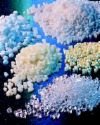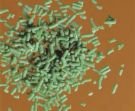I worked at a local bottle making company, just three years ago.
Our plastic came in big cardboard boxes, but was offloaded from those covered hopper cars.
It depended on the type of plastic as to the size of the pellets. HDPE, and LDPE(High[Low] Density Poly-Ethylene) came in pellets about 3/16th of an inch in diameter. PVC(Poly-Vinyal Chloride), came in pellets, maybe 1/8th of an inch, because it took a higher heat to melt.
The pellet color is either clear(PVC), or a neutral(we called it natural) color. Color, which came in pellets also, was added during the mixing process. There was a formula for colorizing the plastic(weight of color, to natural), that would give you the color. Too much color, wrong color, too much natural, lightens the color.
The pellets are so small, you could a small pile of Woodland Sceneics "Snow", to simulate spillage, which, by the way, was very small. More like a pile of sand a loco would leave when sanding the wheels for traction. What spillage that occurs, would be the twenty or so pelltes in the pipe, when the connection was made.With the price of raw plastic, very little was wasted, and was immediatly cleaned up.





